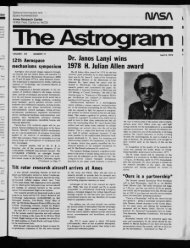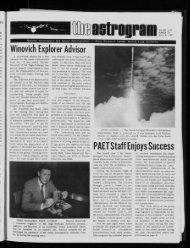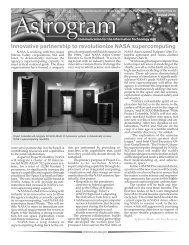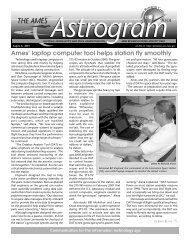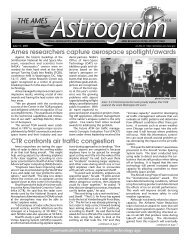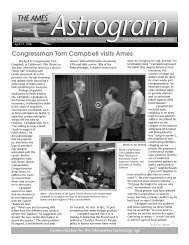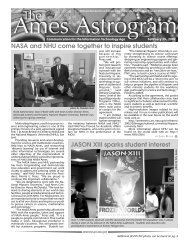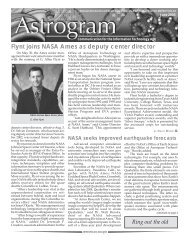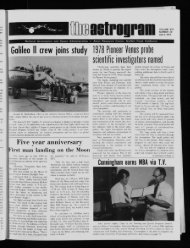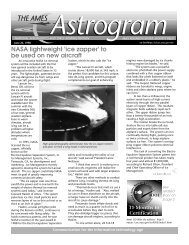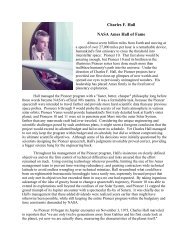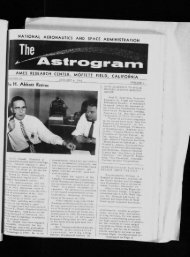1972 December - NASA Ames History Office
1972 December - NASA Ames History Office
1972 December - NASA Ames History Office
Create successful ePaper yourself
Turn your PDF publications into a flip-book with our unique Google optimized e-Paper software.
A comparison of lunar science before and after Apollo<br />
(Continued ~rom Page 1)<br />
less than that of any of ether terrestrial<br />
planets, li we accept the hypothesis that<br />
stony meteorites are samples of the asteroids,<br />
we also observe that the Moon<br />
is lower in density than the parent bodies<br />
of many meteorites. This single fact has<br />
been tin enignla to anyone attemptmg to<br />
infer a chemical composition for the Moon.<br />
Une thing can be clearly concluded lron’l<br />
this fact -- that is, that the Moon has<br />
less metallic iron thau the Earth. The<br />
difference between the lunar cl~nsity and<br />
that of chondritie mete.unites is particu-<br />
larly puzzling because these objects have<br />
compositions that are similar t(~ these o!<br />
the Sun oiler one POrtieres these e, lenlcnts<br />
which form gaseous compounds at moclest<br />
temti~ratures (hydrogen. helium, nitrogen,<br />
carbon, neon, and the other rare gases).<br />
2) The, seemed major charaeteristie of<br />
the Moon goes baek to Galileo, whr~ c)b-<br />
serve.’l thai the Earth-lacing side of the<br />
Moon consisted el mc~unkdnous regions<br />
that he designated terra, and smoother.<br />
physiographic:lily lower regirms which he<br />
designated mare by analogyuiththe terrestrial<br />
:)coons and contin,_,nts. "Fhc albt~do<br />
or refteetivity of these twti regions Xs<br />
markedly different -- the mare regions<br />
bemg very d:frk when compared to the<br />
terra regir~l~s. \stronolnioalstudies ~dded<br />
a great deal of detail tc~ Galileo’s dis-<br />
revery, iecluding som~ rather fbie Iratunes<br />
such as the rilles which ~vere just<br />
barely resolved by good telescopes, lloydever,<br />
- the, cause e’~ this fundan~tqlta i llhysie<br />
graphic difference was no[ well un[lerstoc~d<br />
before the era of .\p~dlo. Fh~. explanation<br />
of relutively slnc)~th ~ll:/re basim:<br />
ranged fr(mi the conclusion thtl they were<br />
very extensive lav:t fields to the hyp,~thesis<br />
Itia t th~y went-, in fact, dust bow~s -tha’t<br />
is, extensive dust deposits. There<br />
were eves s/allw scientists ~ho seri iI.lsly<br />
suggested that they were filled by a tsB?e<br />
of sedinientary rock th;It w:ls dt~pesitcd<br />
at a very early sk~ge in lunar history<br />
when the Moon had an atnlosphere.<br />
3) The origin of the cireul:lr depressions<br />
or craters, which are the n~)st<br />
echelon physiographic feature of the lunan<br />
surface, was the basis O[ Cf;Ulillual<br />
scientific controversy. Two types cff exphlaatioas<br />
Were offered -- first, thil they<br />
were volcanic features sirnilar to terrestrial<br />
culderas or volcanic e¢~Ilapse, fcalures;<br />
secondly, thai they were produced<br />
by projectiles impacting on the lunar surface<br />
in the way that meteorites had occa-<br />
Sionally been observed to fall ml Fk~rth.<br />
4) In parallel with the nolo c~f ~oleanisin<br />
on ~he ltlnar s~lrface, thene wt~r,,<br />
two schools of thought on the thermal<br />
history of the Moon. The first held that the<br />
Xloen was a fairly inactivehodvwhichmav<br />
have undergone some chemical differentiation<br />
which, in any event, took place<br />
very early in ltnlar history. The secone<br />
expected that the Moon was similar to<br />
the Earth with a long and continuous record<br />
of volcanism and chemical differentiation.<br />
Sonic adherents to this school<br />
fully e>:pected that some volcanism may<br />
have persisted to the most recent geo-<br />
logic epochs; that is, as recently as 10miliien<br />
years ago.<br />
5) The chemistry of the lunar surface<br />
was a tot.d unknown before Surwyor<br />
~,. Nevertheless, there were a number of<br />
definite suggestions -- for example, it<br />
was at one time suggested that earhona-<br />
Ceous chcuidrJtes were denived from the<br />
dark mare regsons of the Mooni Others<br />
suggested that type of meteorite known<br />
as ~euerites was representative of the lunar<br />
suriaee, Still others suggested t.hat<br />
a very silica-rich glass found in mysterious<br />
terrestrial objeels called tektites<br />
must represent parts ,Jf the lunar surface.<br />
()no eouki net even be sure tk~t<br />
these hyp~theses were all meonsislent<br />
with e~eh ether. :\t this point in time,<br />
we will ne~t:r know the extent to which<br />
the Surveyor analyses lnay have affected<br />
our understauding of the Moon. The data<br />
returned fron~ these analyses were of<br />
surprisingly high quality. They were~ however,<br />
so quickly superseded by the analyses<br />
of the returned sxmptes that there<br />
~:ls never sufficient time for then,, to<br />
be om~pletety integnated into scientific<br />
thinking on the Moral<br />
t~} Several ()then results obttmed<br />
unalarmed spacecraft helped set the stage<br />
fi~n \p,dlo. The)’ are the disccwery of the<br />
l/]as(’c]ns, which rectu~re a remarkably ri-<br />
gid o:" strong lunar shalle~ intemer -th,~-<br />
determirmtir)n (by Exnler~r 35} that<br />
the Moon had a very weak, perhaps nonexistent,<br />
magnetic field; and finally, the<br />
observation (by both Russian and American<br />
spacecraft) that the lunar backside<br />
was very different from tile frontside<br />
in that dark mare regions were essentially<br />
absent from the backside of th~<br />
2~I con.<br />
AS we anticipate the sixth manned<br />
landing on the lunar surface, we are infinitely<br />
richer in facts concerning the<br />
Moon. Many of the facts and observations<br />
have already been tentatively<br />
assembled into theories and modelswhieh<br />
are leading us to a genuine understnding<br />
of the Moon’s history. In other eases, it<br />
is proving extremely difficult to come up<br />
with an explanation that accounts for all<br />
of these facts in a self-consistent way.<br />
The major areas of understanding which<br />
have come out of the unmanned explora-<br />
Non and five manned landings are briefly<br />
outlined here:<br />
11 ~,e now have a rather definite and<br />
reliable time scale for the sequence of<br />
events in lunar history. In particular, it<br />
has been established with some confidence<br />
that the filling of the mare basins largely<br />
took place between 3.1 and 3.8 billion<br />
years ago. Since these surfaces represent<br />
the major physiographic features on<br />
the lunar surface, we can immediately<br />
infer that the bulk of lunar history recorded<br />
on the surface of the Moon [that is,<br />
the time of formation of more ttzan 90<br />
percent of the craters) took place before<br />
4 billion years ago. This is quite differeat<br />
from the terrestrial situation where<br />
mos~ of the Earth’s ocean basins are<br />
younger than 300 million years, and rocks<br />
older than 3 billion years make up an<br />
almost insignificant proportion of the surface<br />
of the Earth. (Continued Next Issue)<br />
Quick Copy Service<br />
The Quick CoW Sen-ice was established to:<br />
Reduce cowing costs at rate Center.<br />
Reduce time spent by .~es employees<br />
reproducing ~heir own ~,ork.<br />
Provide an essential service for all.<br />
The service has improved greatly in the past year and further<br />
ia’Tprovelnents have recently been made in our facilities. In<br />
most ca;es nhe turnaround time will be 24 hours or less. We<br />
urge all e¢~ployees to utiiize this service whene~ner practical<br />
ask that the %llo~4ng limitations be observed:<br />
1, ~%txirc~n paper si:e is 8 1/2" x 11".<br />
2. ’,taxim~m n~ber of copies is 20 of any, ember of originals.<br />
(Exception to tins iir:dtation requires justification)<br />
3. ,’4o requests that infringe upon copyright or other copying<br />
regulatiorm will be accepted.<br />
4. Contractor requests must be approved by the appropriate<br />
technical re.niter.<br />
To place an order, prepare in duplicate a ~uick Copy ~ork<br />
Order (ARC 58g) and submit it ~2th the ~ork to be copied<br />
a Qaick Copy’ Service envelope (GRC 427) through t}m reguiar<br />
internal mail system.<br />
Page 3



